Self-Striping Sweater
In other news, progress proceeds apace on the Katia Jamaica kid's sweater. I finished the front and the back last night; knitting it in the round up to the armholes means no purl rows so it went fast.

I have a real fondness for self-striping and self-patterning yarns. Purists may say they're a cheat, but I don't care: I love the way you get multi-colored effects without having to weave in numerous ends. I also like how easy it is: you can knit in stockinette and still get an interesting effect. Remember, much of my knitting is done while waiting for little people to take their turn during endless games of Monopoly (with my oldest) or Candyland (with my twins), and so stockinette isn't a bad thing.
I also like the randomness of a self-striping yarn. It can be hard to make stripes or patterns that are truly random; my mind seems to want to impose upon the knitting some kind of order. Two stripes A, four stripes B, two stripes A, four stripes B. With self-striping yarns, there usually is a discernable progression in the order of the stripes, but it often happens so gradually you don't notice it as much. And you may find that the color changes in the middle of a row, or at the end; you may have a repeat that is a little off and not exactly the same as the others; or you may attach another ball that starts at a different place in the repeat, mixing up the color sequence entirely. This drives some people nuts, but for me, it's a kind of manageable chaos, if you see what I mean.
This particular self-striping yarn is interesting because it appears to use deliberate blotching effects, as well as striping. If you look closely, you can see -- especially in the chartreuse stripes -- how little splotches of other colors appear throughout. At first I wondered if this was a sloppy dyeing problem -- I've had self-striping sock yarns with some unattractive blobs of dye hitting the wrong place and it was clear that it wasn't intentional. But these speckles seem to occur throughout, and it looks too deliberate and consistent to be a mistake.
I'll throw out to you one observation I have about working with self-striping yarns. One aspect of using them that can irk knitters is the way in which the stripes change width, often dramatically, within the same garment. If you think about the way these yarns are dyed, it makes sense. Each stripe is a long, long stretch of yarn dyed the same color. Then the next length of yarn is dyed a different color, and so on. You have a finite length of each color. Translating that into knitting: the wider the row you are knitting (i.e. the more stitches in each row), the skinnier your stripes will be. Short little rows, with fewer stitches per row, will make thicker stripes. Think of a Twizzler; it's a finite piece of licorice, so if you stretch it out to make it wider, it's also going to get thinner.
You can see this in my sweater (although I tried to compensate for it a bit).
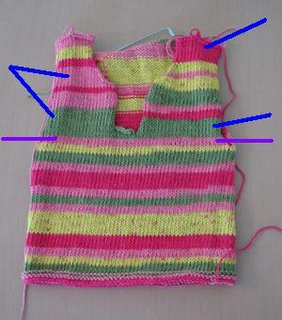
When you look at the part below the armholes (the armhole mark is indicated by purple lines), you can see that the stripes are generally thinner than they are at the upper half. I knit the bottom half in the round, so there were twice as many stitches in each round; this stre-e-e-tched the stripes out and made them thinner. Once I divided for front and back, the stripes got generally fatter, since I was working on half as many stitches. On the front, where I divided again for the placket, the stripes wanted to get even thicker (indicated by the blue lines). (Note the darker green shade in particular.) I compensated for this by deliberately working in a few rows of another color from the other end of the ball, to keep the random flavor of the stripes, but if you look at it analytically, you can see what I mean.
Just remember that when it comes to self-striping yarn, you are the master of the yarn, and not the reverse. You can choose to break the yarn at any time, and switch to another ball, or intersperse a few rows from a different ball to break up a long stretch of one color, if that will improve your satisfaction in the finished product.
You should also pay attention to stripe color when you finish a ball and switch to a new one. You'll get smoother transitions if you find a new ball, or a place in the new ball, where the color matches the color of the stripe you just finished. In other words, if your old ball runs out in the middle of a pink stripe, especially in the middle of a row, you should join a new ball near the end of a stretch of pink. Pick pink, to ease the transition of changing balls; near the end of the pink stretch, so you don't create a wonky pink stripe that is twice as long as the other pink stripes in the garment. (Unless big inconsistencies in stripes and colors don't bug you.)
Busted
My twins came home from nursery school the other day with a flyer about the school's Silent Auction fundraiser. Their school is wonderful, and I never mind supporting their fundraising efforts, since the lion's share of the money they raise goes to a scholarship fund to pay tuition for families who might not otherwise be able to send their kids to nursery school. I had to laugh, though, at this part of the text, asking for donations of items to auction off:
The sky is the limit as far as donations are concerned. i.e. - If knitting is your niche, consider donating a homespun scarf, mittens, etc.
Geez, they might as well have said "Carol S., get your sorry arse knitting and send us something nice to auction off, already!"
So I selected these:

a skein of Colinette Firecracker, the fluffy thing, in order to make a pinky/purple-y foofy scarf that either a mom or her daughter would want to wear (hence the Barbie colors). And a skein of Noro Big Kureyon, with which I will knit a watch-type ribbed cap.
If I finish these and feel particularly ambitious, I'll see what I can find in my stash to make something else, but I have the feeling this will be more than enough to keep me busy until the deadline for submitting items. (Which was, like, yesterday.)
Spinning
I've been plugging away at my spinning, and here's the red Colonial, after plying and setting the twist:
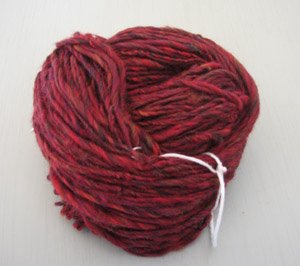
Add tip number 4 to my newbie spinner's tips: once you're done plying (or spinning, if you are going to keep the yarn as "a single," meaning you're not going to ply it with anything but rather leave it as a single ply or strand), you need to "set the twist." You can steam the yarn, or as I do, put it in a sinkful of warm water and soak it, then carefully wring out the extra water, pull the hank from both ends with a little snap, and let it dry. If there's a lot of twist (you'll see the yarn kink up by itself), some people say you can hang a light weight, like a coffee mug strung on a piece of twine through the handle,

from one end as it hangs to dry; this is supposed to help work out some of the excess twist.
I'm now spinning some blue-grey wool, I think it's more of this Colonial,
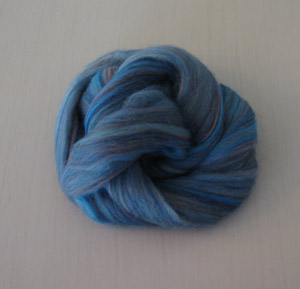
and it's really easy and enjoyable for me to spin. I love the opal-ish color effects of this shade of blue.
Cool Spinning Book
I bought an interesting book on spinning about a year ago. I don't even remember how I stumbled across it; maybe just a domino effect from reading spinning-related blogs: one site linked to another which linked to another which eventually took me to Pluckyfluff. The book is small, and not cheap, but it's self-published (which makes me feel better about the price -- it's going to a real person and not some publishing conglomerate, not that I have anything against publishers, mind you, in case you are a book publishing rep and want to talk about a book deal with me, hint, hint) and has some wonderful photography. It gives you tips on how to create nontraditional effects in your spinning, some of which you can discern from the cover:
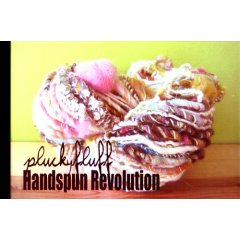
The book is sold on Amazon (although it lists a four to six week shipping time) at a lower price, and on Pluckyfluff's website(link is above), which presumably would have a faster shipping time in exchange for full retail price. This is a book designed to loosen your creativity and create artistic effects with your spinning; it's very perky and upbeat, listing techniques for many special effects, but ultimately urging the spinner to follow her own Muse, as it were. If you're looking for tips on really traditional methods, or a beginner's how-to, this isn't the book for you. If you want some ideas and general techniques for spinning funky novelty-ish yarns, take a look.
One reason why I can't get anything done
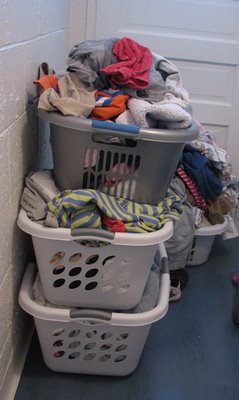
I leave you with a shot of what my laundry room looked like on Monday morning. Note that this does not include the load in the washer or the load in the dryer, or the random socks and Disney Princess underwear (mine, not Grace's*) strewn throughout the house.
*You know I'm kidding about that, right? Because I'm really more of a Dora the Explorer type.






15 comments:
The laundry! The mother's lament. How come Before Kids I did laundry every 10 days or so, and now, with two kids, I do mountains of laundry all week, every week? If I take two days off, it takes that much more time to catch up. And if a gastro-intestinal bug goes through the family, it's even worse.
OWIE! Not a coffee cup! That's much too much weight! Try something a bit lighter. I don't weight my yarns. I just let 'em hang. But the Colonial red looks very good. Excellent first effort and much better than mine was. Keep going.
If you want a tip on dealing with the twist, here's what I do. When I've finished a bobbin of singles, I don't ply it immediately. I let it sit for a day. Usually the other bobbin has been sitting for a while as well. Then I ply and let the plyed yarn sit for a day before I skein it and wash it. Waiting will cause some of the twist to relax.
Some people set the twist by holding the skein over steam. I've done that, using two straight needles so I don't burn myself. However, I prefer to wash the skein. Gets out any residual VM and crap.
I want that mug!!! Trouble is, one child is reading, and another is about to begin. Now you have to knit up that homespun for us. I'm off to explore the Pluckyfluff link- thanks!
Your post could not have come at a better time for me! I just bought a bunch of Katia Jamaica and am planning a little springy something or other for my preschool daughter. I recently finished a baby sweater using Schachenmayr Catania and used Crazy Cotton for the yoke, and really embraced the randomness of the striping. Thanks for the advice and inspiration.
Thank you for noticing, Mindy. I was wondering when someone would pick up on it. Available at Cafe Press -- I think the seller's name is "Mad Knitter." Since I was ordering me a Panoptican sheep shirt, I figured I might as well throw in the mug. Now, like you, I'm trying to figure out when/where I can actually use it. Too profane for the kids at home, too edgy for the customers at the shop.
If I were closer I would praise it everytime I came to the shop! Thanks for the direction.
Darling girl, will you please tell us whether you like the Pluckyfluff products or not?
Because to me, it kinda all looks somewhat too trying too hard to be cool.
Like pre-embroidered, pre-worn-in "hippie" clothing.
I think that using some of her techniques in one's handspinning could produce some really cool-looking yarn, especially for scarves, hats and bags. I don't see myself creating tons and tons of yarn with spider-like hairs hanging out of them, for example, but I do see playing around with the techniques to see what happens. For example, I have a quarter of a bobbin of red yarn left from my last round of spinning, and I'd like to try plying it with some commercial yarn to see what it looks like and how it knits up. Seeing how she plies different strands of things opened up my mind to possibilities I hadn't considered before. I have some odds and ends of roving that I'd like to spin into some bulky singles (using colored tufts of roving in a natural-colored wool) to see if it'd make a cute hat for Grace. Again, something I hadn't considered before. So I guess I have to equivocate a little: I wouldn't want all my spinning to be as nouveau as hers, but I think it'll be fun to play with it in small doses.
You might also like Spinning Designer Yarns, by Diane Varney. I haven't looked through the Plucky Fluff book yet, but a lot of the techniques are covered in the Varney book, as well. I thought it was interesting, even though I'm not really ready to try the techniques.
Thanks, Valerie - I'll check it out. Did you know that when one searches "spinning" on Amazon.com one of the top responses is "Blood Sweat and Tears/Greatest Hits"?
A friend once told me she always knew she was at my house becauase it smelled like fabric softener sheets.
My laundry room is about to become much worse- my washer just dried tonight. (panic!)
There is a piece on spinning novelty yarn (mostly bouclé but some other stuff) in the most recent Spin Off, too. I agree that that sort of thing can provide some inspiration though I haven't tried anything yet.
I sometimes use a hanger as a weight for a skein of yarn (though usually nothing).
As for the mug, can children not be taught that some words are for grown-ups, some for home, etc. Or maybe it should be saved for a cup of hot-chocolate after the kids have gone to bed.
My 4 year old has a funny way of imitating our obscenities. He usually gets the tone absolutely right, but not quite the pronunciation. One I find especially funny is when he yells, "Oh Crisis!" when things go wrong. Well, he's not taking the lord's name in vain...
Love the view of Mt Laundry. Brings back memories of when my kids were little and I'd do 14-18 loads a week. Good luck with your fundraising knitting.
Post a Comment